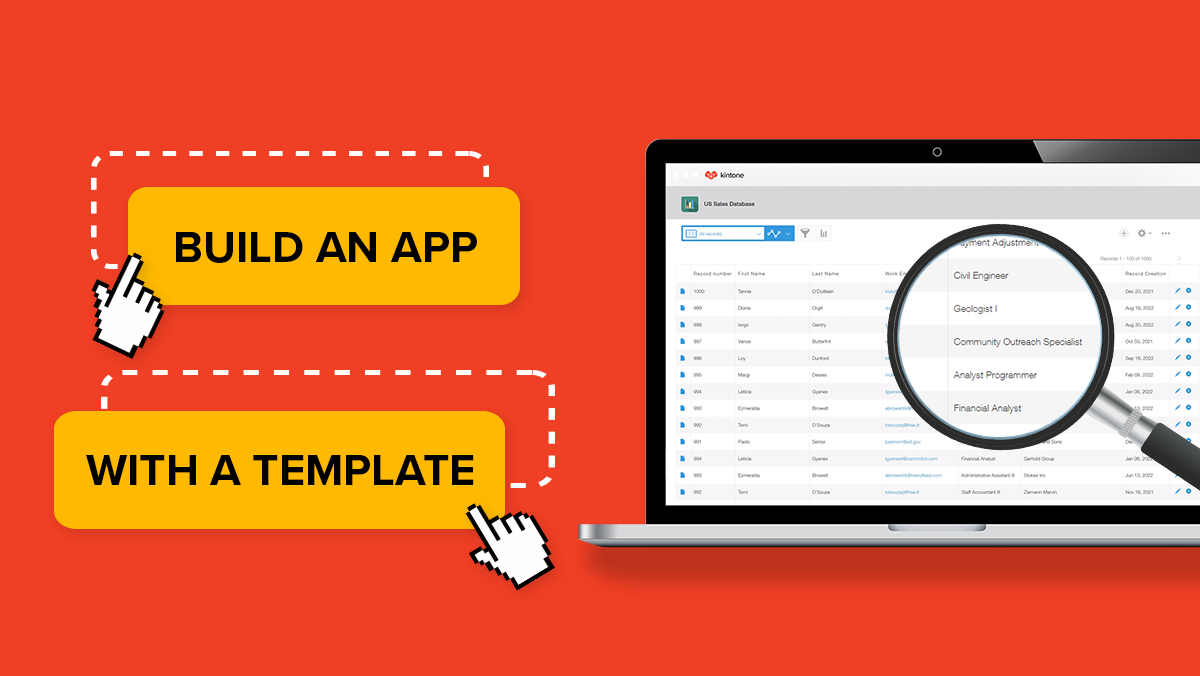Multi-tasking tools often get a bad rap. When something is touted to be a 2-in-1 product, it typically doesn’t do either function all that well.
And you might assume the same goes for software. But fragmenting your work into 15 different software platforms to communicate with your team and organize your data and projects is probably killing you slowly, even if you don’t realize it yet.
The result is this: The average computer-using worker spends 20% of their week searching for internal information according to McKinsey. We waste hours digging through our inboxes, past chat messages, and various software tools to find the information we need to do our jobs.
This is why at Kintone we have a bit of a radical view on communication.
Conversations are data, too.
Conversations provide a lot of context for decision making and strategy, but they often happen in private channels like email, chat, or meetings. At the end of the conversation, the conclusion is shared with the broader team, but the thought process leading up to the conclusion is left out. This thought process, as well as the collaboration needed to get through this thought process could be highly valuable to the rest of the team to learn and understand.

To illustrate this, part one of the image above shows Bob and Erica troubleshooting a problem together, but the conversation happens in a private chat channel. Problem solved, right? Sure, but as shown in part two, the rest of the team wasn’t privy to the problem-solving process. And as you can see in part three, if Bob and Erica leave the company either for good or for a week-long vacation and a similar issue comes up, the rest of the team won’t have Bob and Erica’s conversation to refer back to and will have to troubleshoot the issue all over again.
We’re not the only ones who’ve seen the value of conversations. Integrated chat into software tools is a growing trend, one that will only continue to expand as we’ve come to rely on so many different tools to get our work done.
One tool to rule them all: the value of Kintone's integrated chat features
Not only is it crucial to value your communication, you also need to think about how to keep it all organized and accessible. The Kintone platform allows every department to build custom portals for what they need with customized workflows for every task and project—and of course, integrated communication throughout it all.
To keep all this information organized and easy to find, Kintone's platform has several baked-in features that allow for integrated chat between teammates, departments, and even people who may have no immediate working relationship with one another, because sometimes teamwork doesn't always come in predictable pairs.
These integrated chat tools are designed with teamwork in mind, and we feel teamwork is done best with everything open and visible by default. So that’s how the Kintone platform works. Of course, you do have the option to make things private when necessary (the whole company doesn’t need to know your social security number, for example).
How Kintone keeps your communication organized
Spaces: organized groups of data and conversation
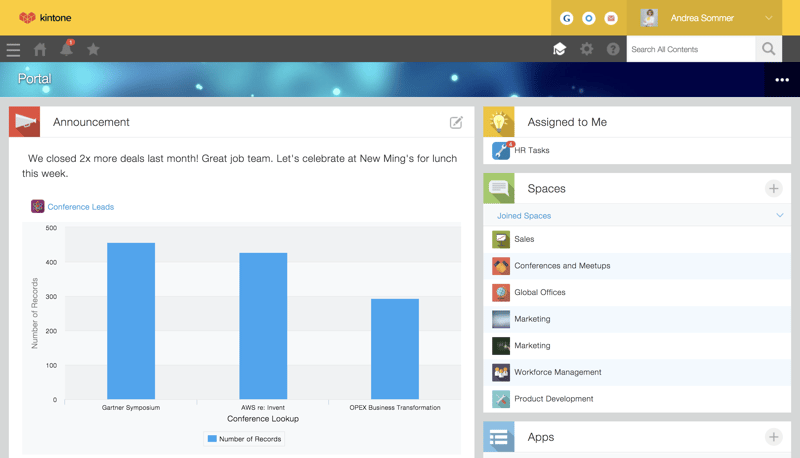
These are essentially mini portals customized for each department, team or project. Spaces are blank canvases, where you can put the most important information and conversations for a specific group of people front and center. For example, at Kintone we have a sales space, a marketing space, an HR space, and many more.
The goal is to curate what that group of people will want to access or would find useful during their day-to-day work. We’ll go into the various components within a space in just a moment, but the key component for communication here is the Announcement Panel on the left (image above). You can include text, images, links, data points in the form of a table or chart—whatever you want your team to see right when they log in.
Apps: customizable databases that house conversations alongside each data point
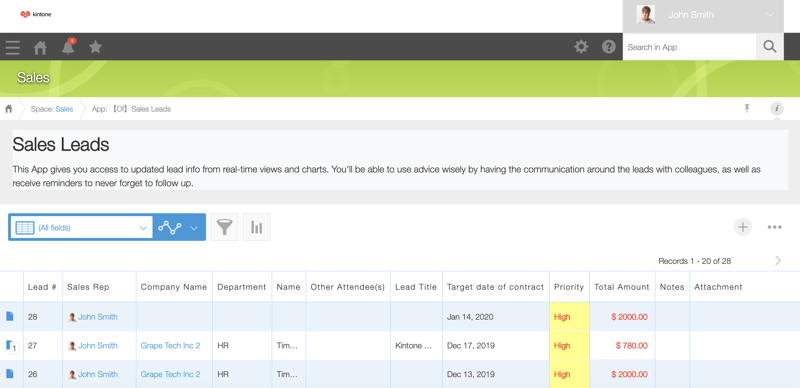
This is where the magic happens. Kintone apps are essentially databases that can be customized to manage tasks or workflows, everything ranging from expense reports for the HR team to a content calendar for marketing. Sales teams can build a lead management or CRM app (pictured above), and customer success can have that filter into a customer database once sales are closed.
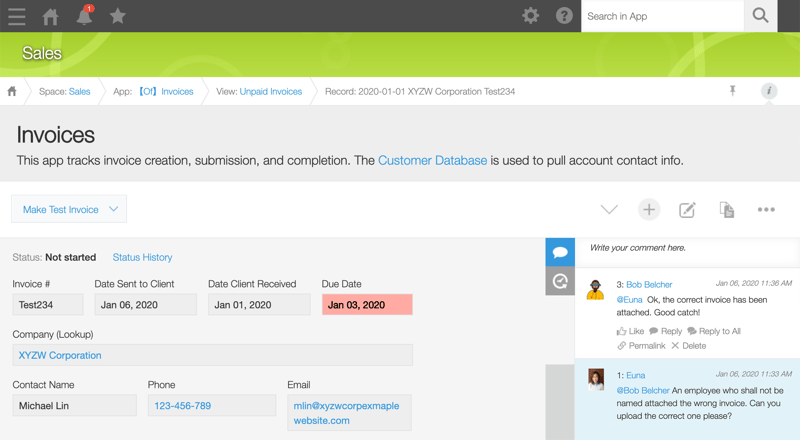
Alongside each record in the apps, whether that’s a specific invoice, expense report, or sales lead, you can communicate directly in the comment panel on the right side, tagging relevant team members or departments (pictured above). This in-app communication makes it easy to see what conversations have happened about this particular data point. Because it’s all visible to everyone by default, if someone in marketing wants to see what’s going with a customer in the customer database, they can do so, even if they aren’t tagged in that record.
If someone leaves your team (sad, but such is life), the new hire taking over the project can come in later and catch up on past conversations that otherwise would have been trapped in past email or chat messages, inaccessible and therefore useless.
Learn more through the story of Musical Empowerment, the nonprofit organization that cleaned up their communication and data management processes using Kintone. With an ever-changing volunteer base of college students, Allison Flors, COO, found herself chasing down info over Facebook and LinkedIn after volunteers graduated. Learn how she fixed it here.
Meeting minutes: the somewhat boring but game-changing app for your team’s collaboration
Our meeting minutes app is easily the most used app in our marketing space. We take detailed meeting minutes, noting who said what, for a few different reasons.
- If team members are out of the office, they can easily see what they missed. Of course, we can also record video meetings, but watching those can be time-consuming. Detailed meeting minutes that share who said what let people catch up quickly.
- This makes everything, including action items and who they’re assigned to, absolutely clear. If everyone takes their own notes separately, you’re leaving opportunities for miscommunication or a general lack of clarity. Having one primary set of notes that everyone can refer back to and comment on can help build better accountability amongst your team.
Threads: Forums for conversations around a given topic or project
For ongoing communication around a specific topic, threads function as a forum where you can create new posts, add comments, and tag specific people and teams. Threads are great for announcements as well as ongoing conversations. For example, our HR team uses various threads in the HR space to communicate announcements and updates to our entire company. They have a thread for general updates, new hire announcements, a special new one for COVID-19 related updates, and many more.
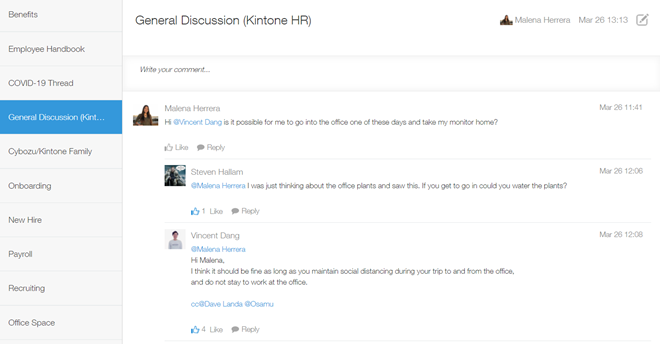
Threads are time and effort-saving gifts from the heavens. Here’s why:
- Our HR team no longer has to answer the same questions over and over via separate email inquiries. Team members can post their questions on a thread where the information is visible to all, and non-HR team members can chime in and comment if they already know the answer. This is collaboration at its finest. And of course, the rest of us (not on the HR team) also have our own threads set up for the most important topics for each department, all organized in our own spaces.
- Past conversations on threads are searchable and accessible for current and future employees to refer to and learn from. Each post and comment has its own permanent link, so you can easily share a comment to another team member to reference.
Read also: How Kintone Helps Our HR Team Get More Done
Walls: A place to share what you want
Just like some of our favorite social media platforms, Kintone users have a “wall” where they can post updates, images, links, and more. Internally at Kintone, we use these for both work-related and personal updates. Our sales and customer success teams often post weekly updates sharing what’s in the pipeline and tasks on their plate, tagging any relevant colleagues or groups.
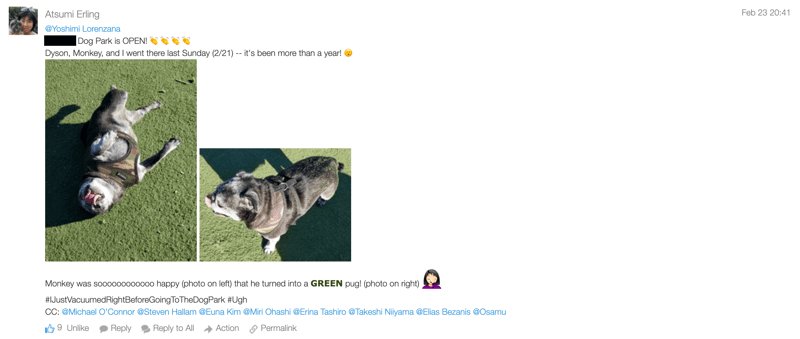
We also have team members who love to share personal updates, favorite recipes, interesting articles, and photos (see above).
Direct Messages: When you need a quick one-on-one chat
Finally, for conversations that need to be private or just need a quick exchange of info, you can hit them in the DMs. Direct messaging on Kintone, just like on many other platforms, lets you share links, files, and quick messages with other team members—this is ideal for conversations you don’t necessarily feel that anyone else would benefit from.
Final takeaways
The tools we use to communicate often become a junk drawer of sorts, and we end up wasting a solid chunk of our time searching through that junk drawer for the info we need. By valuing our conversations as much as we value our data, we can drastically improve the way we collaborate and get our jobs done.
The Kintone platform provides various channels for communication that emphasize visibility and accessibility—which we believe, leads to better teamwork. To learn more about how Kintone can improve your team’s communication and see it in action, view our webinar featuring Allison Flors, COO of nonprofit organization Musical Empowerment: How to Organize Your Team’s Communication With Kintone.
About the Author
Euna is a Senior Content Specialist at Kintone. She holds a BA in English from the University of Michigan and has a thing for words, food, and travel.








